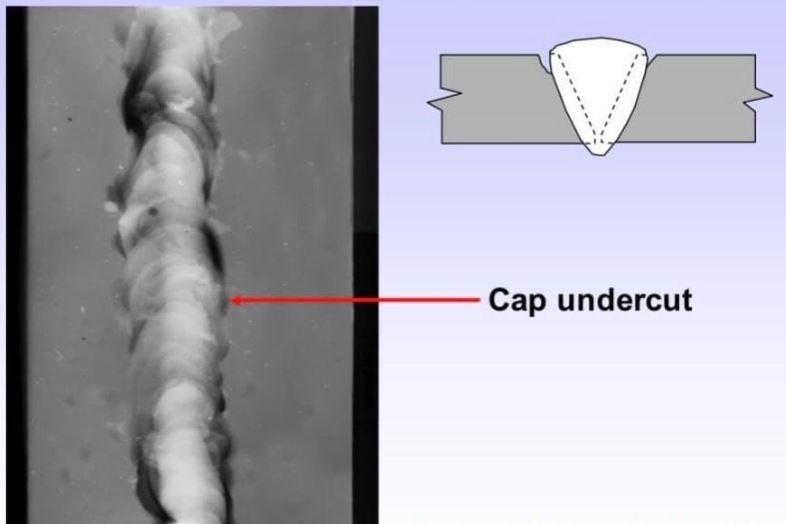Recognizing the Causes and Solutions for Undercut Welding in Metal Construction Procedures
In the realm of metal fabrication procedures, the occurrence of undercut welding postures a substantial obstacle that requires a comprehensive understanding of its reasons and viable options. The detailed interaction of various aspects throughout welding operations can result in this undesirable sensation, impacting the architectural honesty and overall high quality of the welded joints - Preventing weld undercut. By studying the origin of undercut welding and checking out reliable therapeutic actions, producers can boost the criterion of their handiwork and make certain the production of remarkable steel components
Common Causes of Undercut Welding
Regularly forgotten in steel fabrication, undercut welding occurs due to different aspects that require thorough focus and proficiency to be efficiently alleviated. Furthermore, inappropriate welding strategies, such as making use of the incorrect welding angle or take a trip rate, can additionally add to damage development. The selection of welding parameters, such as voltage, present, and cable feed rate, plays a significant function in the event of undercut welding.
Effect of Incorrect Welding Parameters
Imprecise welding specifications can significantly endanger the integrity and high quality of bonded joints in metal construction procedures. The effect of wrong welding specifications shows up in numerous methods, causing structural weaknesses and defects in the bonded elements. One important element affected by improper welding criteria is the infiltration depth of the weld. Insufficient warmth input because of low welding currents or excessively high traveling rates can result in inadequate blend between the base metals, bring about incomplete joint penetration and damaged bonds. On the other hand, excessive warmth input brought on by high welding currents or slow traveling speeds can lead to extreme and burn-through reinforcement, developing a fragile and unpredictable weld framework. Additionally, inaccurate parameters such as inappropriate voltage settings or wrong electrode angles can contribute to irregular weld bead accounts, lack of blend, and enhanced chances of flaws like undercutting. Meticulous interest to welding criteria is extremely important to make certain the production of top notch welds with the wanted mechanical homes and architectural integrity.
Result of Improper Lantern Angle
Inappropriate lantern angle in welding procedures can dramatically influence the quality and integrity of the last weld joints in steel manufacture procedures. The lantern angle plays a crucial role in identifying the warm input and distribution during welding. When the torch angle is incorrect, issues such as undercutting can occur. Undercutting is a common welding problem where a groove forms along the weld toe, weakening the joint and compromising its architectural honesty.
A lantern angle that is also steep can result in insufficient infiltration, insufficient combination, and increased spatter. On the various other hand, a lantern angle that is as well shallow can cause extreme penetration, burn-through, and distortion of the base product. Preventing weld undercut. Appropriate torch angle is crucial for making certain constant weld quality, toughness, and appearance
To avoid damaging and other defects brought on by incorrect lantern angles, welders need to be trained to keep the appropriate lantern angle throughout the welding process. Normal tracking and adjustment of lantern angles during welding can assist achieve audio welds with minimal issues.
Role of Inadequate Welding Strategies

Another aspect of inadequate welding techniques is inappropriate weld prep work. Poor cleansing of the base metals, inaccurate joint style, or inadequate edge preparation can all pop over here add to damage welding. In addition, insufficient protecting gas protection or using the incorrect kind of gas can lead to incomplete fusion and the development of undercut flaws.
To attend to the role of inadequate welding strategies in metal fabrication procedures, it is vital to supply extensive training for welders. Proper education and learning on welding specifications, joint preparation, and protecting gas selection can aid stop undercut welding and guarantee high-quality welds in steel fabrication tasks.
Efficient Solutions for Undercut Welding
Addressing undercut welding in steel fabrication calls for executing reliable options to enhance weld high quality and structural stability. One of the main solutions to deal with undercut is to adjust welding specifications such as voltage, current, and travel rate to guarantee correct heat input and combination. By fine-tuning these settings, welders can stop too much melting of the base metal and filler product, reducing the probability of undercut development.
Additionally, correct joint preparation is important in protecting against undercut. Guaranteeing tidy base steel surfaces without impurities and using the proper bevel angle can aid promote much better weld infiltration and lower the risk of undercut - Preventing weld undercut. Utilizing ideal welding techniques, such as oscillating the lantern or weaving, can additionally assist in distributing heat uniformly and loading the weld joint appropriately, decreasing the possibility of undercut problems
Furthermore, picking the right welding consumables, including electrodes and filler metals, is vital in minimizing undercut. Making use of products with appropriate chemical compositions and mechanical buildings can add to achieving sound welds with minimal undercut. Regular inspection and quality control steps ought to likewise be executed to discover and attend to undercut problems immediately, making sure the general stability of produced metal components.

Conclusion
To conclude, recognizing the reasons and options for undercut welding in steel construction processes is crucial for achieving high-quality welds. By resolving usual reasons such as inaccurate welding parameters, inappropriate lantern angle, visit homepage and insufficient welding techniques, welders can prevent damaging and make sure strong, durable welds. It is important to take notice of these aspects and execute reliable options to improve the total welding procedure and final item high quality.
